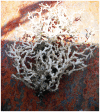Comparing deep-sea fish fauna between coral and non-coral "megahabitats" in the Santa Maria di Leuca cold-water coral province (Mediterranean Sea)
- PMID: 23028551
- PMCID: PMC3454424
- DOI: 10.1371/journal.pone.0044509
Comparing deep-sea fish fauna between coral and non-coral "megahabitats" in the Santa Maria di Leuca cold-water coral province (Mediterranean Sea)
Abstract
Two experimental longline surveys were carried out in the Santa Maria di Leuca (SML) cold-water coral province (Mediterranean Sea) during May-June and September-October 2010 to investigate the effect of corals on fish assemblages. Two types of "megahabitat" characterized by the virtual absence of fishing were explored. One was characterized by complex topography including mesohabitats with carbonate mounds and corals. The other type of megahabitat, although characterized by complex topographic features, lacks carbonate mounds and corals. The fishing vessel was equipped with a 3,000 m monofilament longline with 500 hooks and snoods of 2.5 m in length. A total of 9 hauls, using about 4,500 hooks, were carried out both in the coral megahabitat and in the non-coral megahabitat during each survey. The fish Leucoraja fullonica and Pteroplatytrygon violacea represent new records for the SML coral province. The coral by-catch was only obtained in the coral megahabitat in about 55% of the stations investigated in both surveys. The total catches and the abundance indices of several species were comparable between the two habitat typologies. The species contributing most to the dissimilarity between the two megahabitat fish assemblages were Pagellus bogaraveo, Galeus melastomus, Etmopterus spinax and Helicolenus dactylopterus for density and P. bogaraveo, Conger conger, Polyprion americanus and G. melastomus for biomass. P. bogaraveo was exclusively collected in the coral megahabitat, whereas C. conger, H. dactylopterus and P. americanus were found with greater abundance in the coral than in the non-coral megahabitat. Differences in the sizes between the two megahabitats were detected in E. spinax, G. melastomus, C. conger and H. dactylopterus. Although these differences most probably related to the presence-absence of corals, both megahabitats investigated play the role of attraction-refuge for deep-sea fish fauna, confirming the important role of the whole SML coral province as a refuge area from fishing.
Conflict of interest statement
Figures











References
-
- Roberts JM, Wheeler A, Freiwald A, Cairns SD (2009) Cold-Water Corals: The Biology and Geology of Deep-Sea Coral Habitats. Cambridge University Press, Cambridge.
-
- Söffker M, Sloman KA, Hall-Spencer JM (2011) In situ observations of fish associated with coral reefs off Ireland. Deep-Sea Res I 58: 818–825.
-
- Mortensen PB, Hovland M, Brattegard T, Farestveit R (1995) Deep water bioherms of the scleractinian coral Lophelia pertusa (L.) at 64° N on the Norwegian shelf: structure and associated megafauna. Sarsia 80: 145–158.
-
- Mortensen PB (2000) Lophelia pertusa (Scleractinia) in Norwegian waters: distribution, growth, and associated fauna. Dr scient. Thesis. Department of Fisheries and Marine Biology, University of Bergen.
-
- Husebø A, Nottestad L, Fosså JH, Furevik DM, Jorgensen SB (2002) Distribution and abundance of fish in deep-sea coral habitats. Hydrobiologia 471: 91–99.
Publication types
MeSH terms
LinkOut - more resources
Full Text Sources

